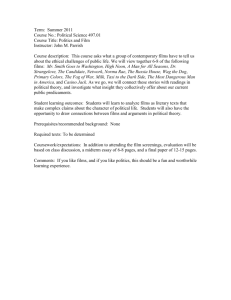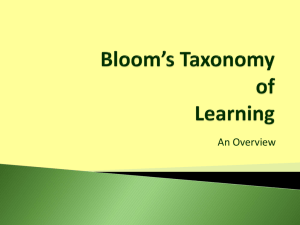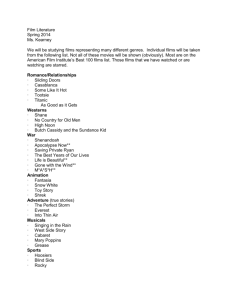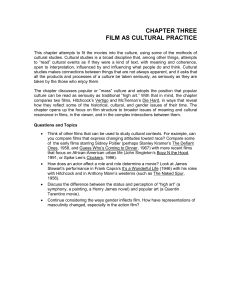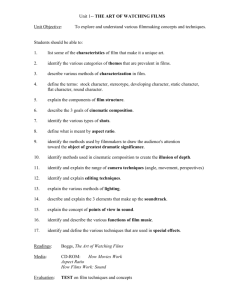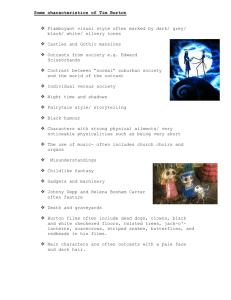File - Media and Film Studies
advertisement
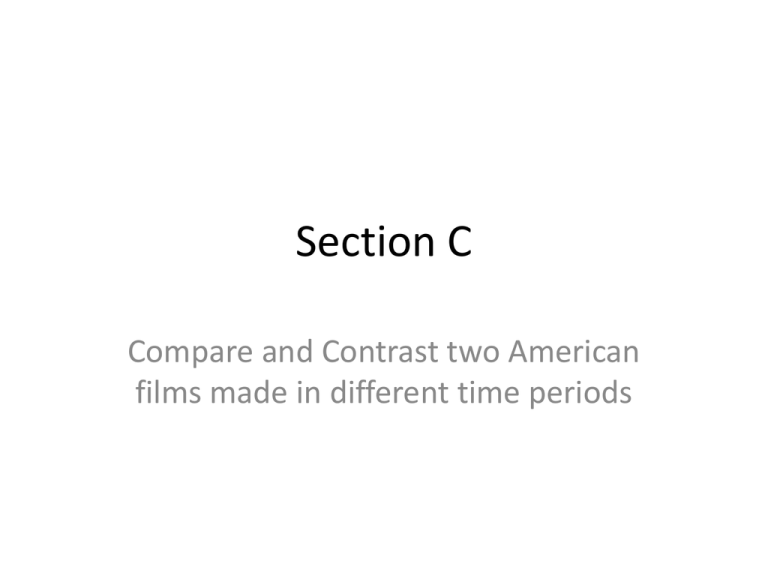
Section C Compare and Contrast two American films made in different time periods The two films we are going to study What do I have to revise for the exam? • • • • • • • • • • You need to compare and contrast the two films in terms of the following categories: Context – How do both films reflect America in the 1950’s and 1980’s? Messages and Values – Themes of the films (Have they changed? Why?) Genre – (They are both Sci Fi/Horror films) How do we know this? What has changed? Why? Gender – How are men and women represented in the two films? Does this representation change over time? Narrative – How are the two films structured? Does this change over time? Key scenes – You need to analyse key scenes of the films to reinforce your arguments in the categories above Place – How does the setting of each film support the themes/messages and values of the films? Opening/Ending scenes – Why are these important in establishing the context/gender etc of the two films? Conflict – How is conflict established in the two films? Do the two films differ in terms of conflict? Science Fiction films – Key Points • Science Fiction films have often been used to provide social commentary on political or cultural issues which are seen to be important at the time of the film’s release, as well as been used to explore the issue of what it means to be human. • The genre also plays on audience’s fears by having a monster which represents (acts as a metaphor) fears that the society have at the time of the film’s release. This fear changes over time Historical Background – Essay Plan • • • • • • • • I would start this essay with the point that both of the films studied are easily recognizable as sci-fi/horror films because the codes and conventions of both films are similar: An isolated setting A threat from a monster The use of the non diegetic soundtrack to build suspense However film genres do change over time and this is why it is important to study historical background. The audience change because their expectations of what they expect from a scifi/horror film changes from generation to generation. This is down to technological changes (special effects) cultural changes (the abolition of The Hays Code) and historical change (the horror of watching Vietnam on television news) 1950’s discussion (see slides) – linked to key scenes and examples from film 1980’s discussion (see slides) – linked to key scenes and examples from films 1950’s context/background: The key factors to know • • • • • • • • Fear of scientists caused by the atomic bomb Army are to be trusted (success at WWII) Monster represents fear of Russia and Communism This fear was seen in American society at the time by Senator McCarthy’s witchhunts. UFO’s were believed to be true (Roswell 1947) Americans had a fear of ‘brainwashing’ (Korean War and treatment of POWs in this war) Teenagers had more disposable income and with the Paramount Decree this meant there was an opportunity to release films directly aimed at this new market. The rise of television ownership also meant that many older people stayed away from the cinema for a time. Teenagers very often went to Drive-Ins to see their films. The Hays Code restricted what could or could not be shown on the big screen. This affected the content of sci-fi/horror films. Scientists were feared at this time in history - the effects of the atomic bomb • The dropping of the Hiroshima and Nagasaki bombs meant that people saw the full might of what humans could do to other humans. This created fear and because of this, scientists were very often cast as villains in 1950’s films. American soldiers were seen as heroes and were to be trusted • American soldiers won WWII and this brought about a period of prosperity and hope for the American people. Soldiers were seen as heroes and were very often cast as such in films of the 1950’s. It was ‘right’ that we trusted their views on situations, it was ‘natural.’ The monster represents the fear of Russia and communism (external threat) • Russia emerged as the new threat after the defeat of Germany and many Americans feared what they could do to democracy. Communism was also seen as a threat because it was alien to American’s belief of looking after yourself and your family. This ‘threat’ was exaggerated by Senator McCarthy (witch-hunt) • This man made insubstantial claims that communists had infiltrated the president’s office and this led to a witch-hunt of innocent Americans who McCarthy believed were working for Russia. He centred his search on the film industry. UFO’s were embedded into the American consciousness (Roswell 1947) • Many Americans believed in aliens after this incident in 1947. Sightings of fairies and angels in the USA as people began to see ‘lights in the skies’ There was a perceived threat that people could be ‘brainwashed’ (Korean War) • Brainwashing meant that Americans could be controlled by a foreign invading force and this was a relevant fear at the start of the 1950’s. This fear was set in motion by accounts of POW treatment in The Korean War. Rise of Teenagers and disposable income/ Increase of content at the cinema • A ‘baby boom’ at the end of WWII created in time a new generation of teenagers who wanted their own form of entertainment which was separate from their parents. With work plentiful and many adults staying at home to watch televison a new market was created for filmmakers and they flocked to see science fiction films The Drive-In • The Drive In was created to capitalise on the growth of car ownership in the 1950’s. Teenagers were buying new cars and they were quickly drawn to these kind of cinemas were they could have a cheap date away from the prying eyes of their parents. The kind of films they wanted to see were very often sci-fi and horror films. The Hays Code • The Hays Code was a set of industry censorship guidelines created to protect American people from subversive material on the big screen. This meant that horror films couldn’t really show any real ‘gore’ because of the perceived effect that this may have on the audience. 1980’s Context: Things you need to know • • • • • • • • • • Theme of distrust was evident in American society during the 1970’s and 1980’s Suburban living – fear of neighbours, not knowing who lived next to you President Nixon – Watergate Scandal – lying to American people Vietnam War – scarred America, 58,000 American soldiers died, American soldiers seen to be more the enemy rather than triumphant Vietnam War – Body Horror – images of death and destruction played nightly on American televisions – influenced horror and science fiction films of the time Hays Code – scrapped in 1960’s Fear of Aids – spread invisibly, attacked the body Yuppies – selfishness and an attitude which privileged individuals rather than communities, led to a ‘me’ attitude where people didn’t help other people. Civil Rights campaign – fanned the flames of discontent between whites and blacks Kent State shootings – American serviceman fired on American students on American soil The Theme of Distrust • America in the 1970’s and early 1980’s was a place where the people had lost trust in its government, its army and with each other. • This graph (black line) shows the level of distrust that people had in its government at this time . • The reasons for this distrust are many and they influenced science-fiction and horror films of the 70’s and 80’s. President Nixon – Watergate Scandal • • • The Watergate Scandal linked President Nixon to a break in committed by members of his party against the opposing Republican party where cash was stolen to help fund his re-election campaign. He at first denied all knowledge of this, but as the truth began to dawn he was forced to resign from being President. If the President of America directly lied to the American people you can see why the mid to late 1970’s was seen as a period of distrust in American society. Kent State Shootings • • • The Kent State shootings involved the shooting of unarmed college students by the Ohio National Guard on Monday, May 4, 1970. The guardsmen fired 67 rounds over a period of 13 seconds, killing four students and wounding nine others, one of whom suffered permanent paralysis. With American military firing on American people who were protesting against Vietnam and President Nixon’s speech on Cambodia the real sense of distrust can be seen graphically in this picture (taken a few seconds after the student on the ground had been shot) These shootings became a rallying point for more Vietnam War protests to follow. Vietnam War – Scarred America • • • • Vietnam was the first war where a number of American people vocally opposed the involvement of the American army in a campaign far away from American soil. 58,000 Americans died and for the first time in their history America didn’t ‘win’ the war due to effective guerrilla campaigns employed by the Vietnamese. This led to prolonged protests in America opposing the war throughout the late 1960’s and 70’s. Psychologically the War affected the American psyche with many American War Veterans ignored when they came home, many Americans didn’t want to admit defeat and they took out their frustrations against the Government Vietnam War – Body horror • • • Vietnam was the first ‘televised’ war and Americans were confronted with many horrific images every night on their news programmes. This focus on the destruction of the body led to a new focus for science fiction and horror films of the time, where the focus of the horror in the films became one of the destruction of the body. As the director of The Thing, John Carpenter stated ‘the monster couldn’t be a guy in the suit’ because obviously what frightened the audience in the 1980’s was radically different from the 1950’s. Fear of AIDS • • • At the start of the 1980’s word began to spread of a new virus/disease called AIDS which spread invisibly between people. This new disease led to fears of people being infected and although the film The Thing is not about the disease itself, it does dwell on ‘fears’ of being contaminated by an unknown enemy which is a clear metaphor for the disease itself. The ‘monster’ in the film is thus not an ‘external’ threat like Russia or Communism, it is an internal threat which represented the distrust in America at the time of release and the fear of being invaded by an invisible force. Civil Rights Campaign • • To add to the distrust in America at this time in their history the Civil Rights campaign made clear that the black minority in the country wanted their voice to be heard, as well as obviously wanting to be treated with respect and not second class citizens. Figures like Rosa Parks and Martin Luther King became symbols of freedom and respect in the 1960’s and added to the feeling of distrust in the country. Suburban Living • Rapid home growth in the 1960’s combined with cheaper mortgages, inexpensive air travel, cheaper cars and the American mentality of spreading your roots meant that by the end of the 70’s many people had moved far away from their home towns • This led to a country where people didn’t know who they were living next to and also the perception that extended families were breaking up. • This added to the climate of mistrust in the early 1980’s Yuppies • • • The start of the 1980’s saw a rise of people called Yuppies whose goal was solely to make money, to see coworkers as competitors and to put themselves above and beyond the community. This selfish nature can be directly linked to the rise of distrust in America in the 1970’s and is reflected in the film The Thing. When watching the film notice how different the people work together to that of the soldiers in the 1950’s. Scrapping of The Hays Code • • • By the mid 1960’s The Vietnam war and radical social changes in society meant that The Hays Code was ridiculously outdated, so over time many films started to increase the violence, sex and swearing contained in movies. One film which demonstrated this break with The Hays Code was Bonnie and Clyde, which ended with a gruesome shoot out where the two protagonists are shot repeatedly with rapid machine gunfire. Screen Violence changed as a result and this was reflected in the science fiction/horror films of the 1970’s/80’s. Messages and Values - Essay • • • • • • • • I would start this essay with the point that both of the films studied are easily recognizable as sci-fi/horror films because the codes and conventions of both films are similar: An isolated setting A threat from a monster The use of the non diegetic soundtrack to build suspense However film genres and the messages and values that they contain do change over time and this is why it is important to compare and contrast two American films made in different decades The audience change because their expectations of what they expect from a sci-fi/horror film changes from generation to generation. This is down to technological changes (special effects) cultural changes (the abolition of The Hays Code) and historical change (the horror of watching Vietnam on television news) 1950’s messages and values - fear of scientists (Hiroshima), the value of believing that soldiers are ‘right,’ (WWII) the fear of Russia (WWII, McCarthy) – Hays Code 1980’s messages and values – ‘the sustained metaphor of the collapse of identity, responsibility and trust in the modern world’ (Robert Cumbow) – Watergate, Suburban living, Kent State, Civil Rights and the frailty of the human body – threat from Aids, the images from Vietnam
